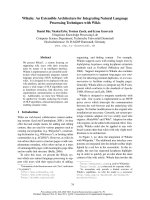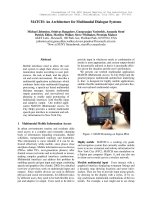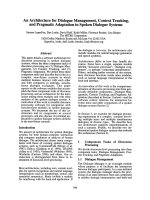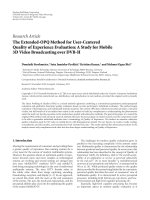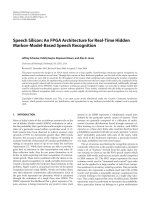An architecture for user configurable mobile collaborative geographic applications
Bạn đang xem bản rút gọn của tài liệu. Xem và tải ngay bản đầy đủ của tài liệu tại đây (1.79 MB, 134 trang )
QUEENSLAND UNIVERSITY OF TECHNOLOGY
Faculty of Information Technology
Microsoft QUT eResearch Centre
An Architecture for User Configurable
Mobile Collaborative Geographic
Applications
Masters by Research Dissertation Prepared for August
Student:
Chien Jon SOON
BEng(Hons)(Electronics) / BInfoTech(SoftwareEng) QUT
Principal Supervisor:
Professor Paul ROE
Associate Supervisor:
Dr Dian TJONDRONEGORO
An Architecture for User Configurable Mobile Collaborative Geographic Applications
Abstract
Geographic information is increasingly being touted for use in research and industrial projects. While
the technology is now available and affordable, there is a lack of easy to use software that takes
advantage of geographic information. This is an important problem because users are often
researchers or scientists who have insufficient software skills, and by providing applications that are
easier to use, time and financial resources can be taken from training and be better applied to the
actual research and development work.
A solution for this problem must cater for the user and research needs. In particular it must allow for
mobile operation for fieldwork, flexibility or customisability of data input, sharing of data with other
tools and collaborative capabilities for the usual teamwork environment.
This thesis has developed a new architecture and data model to achieve the solution. The result is
the Mobile Collaborative Annotation framework providing an implementation of the new
architecture and data model. Mobile Collaborative Mapping implements the framework as a Web
2.0 mashup rich internet application and has proven to be an effective solution through its positive
application to a case study with fieldwork scientists.
This thesis has contributed to research into mobile computing, collaborative computing and
geospatial systems by creating a simpler entry point to mobile geospatial applications, enabling
simplified collaboration and providing tangible time savings.
i
An Architecture for User Configurable Mobile Collaborative Geographic Applications
ii
An Architecture for User Configurable Mobile Collaborative Geographic Applications
Table of Contents
Abstract .................................................................................................................................................... i
Table of Contents ................................................................................................................................... iii
Table of Figures ...................................................................................................................................... ix
Table of Tables ....................................................................................................................................... xi
Statement of Original Authorship ........................................................................................................ xiii
Acknowledgements ............................................................................................................................... xv
1
Introduction .................................................................................................................................... 1
1.1 Background ................................................................................................................................ 1
1.1.1
Location Detection and Positioning .................................................................................. 1
1.1.2
Spatial Location Information in Field Data Collection ....................................................... 2
1.1.3
Web 2.0 and Rich Internet Applications ........................................................................... 3
1.1.4
Online Collaboration ......................................................................................................... 3
1.2 Aims and Contributions ............................................................................................................. 4
1.3 Research Questions ................................................................................................................... 4
1.4 Requirements of a Mobile GIS for Fieldwork Ecologists ............................................................ 5
1.4.1
Mobility ............................................................................................................................. 5
1.4.2
Software Architecture ....................................................................................................... 5
1.4.3
Geographic ........................................................................................................................ 6
1.4.4
User Configurability ........................................................................................................... 6
1.4.5
Collaboration ..................................................................................................................... 6
1.5 Roadmap .................................................................................................................................... 6
1.6 Summary .................................................................................................................................... 7
2
Literature Review ............................................................................................................................ 9
2.1 Mobile Computing ................................................................................................................... 10
2.1.1
Mobile Computing Devices ............................................................................................. 10
iii
An Architecture for User Configurable Mobile Collaborative Geographic Applications
2.1.2
Device Constraints and Limitations ................................................................................. 14
2.1.3
Overcoming Mobile Device Constraints and Limitations ................................................ 16
2.1.4
Mobile Users ................................................................................................................... 17
2.2 Context Awareness and Adaptation ........................................................................................ 17
2.2.1
Context ............................................................................................................................ 18
2.2.2
Location Awareness ........................................................................................................ 19
2.2.3
Context Aware Adaptation ............................................................................................. 19
2.3 Geospatial Applications ........................................................................................................... 20
2.3.1
Geographic Information Systems .................................................................................... 20
2.3.2
Mobile Geographic Information Systems ....................................................................... 21
2.3.3
Online Map Rich Internet Applications ........................................................................... 21
2.3.4
Map Mashups .................................................................................................................. 22
2.3.5
Other Mobile Geospatial Applications ............................................................................ 23
2.3.6
Context Aware Adaptation in Geospatial Applications .................................................. 24
2.4 Service Oriented Architecture ................................................................................................. 26
2.4.1
Origins of Service Orientation ......................................................................................... 26
2.4.2
Principles of Service Oriented Architecture .................................................................... 26
2.4.3
Web Services ................................................................................................................... 27
2.4.4
Resource Oriented Architecture and Representational State Transfer .......................... 28
2.5 Component Technology ........................................................................................................... 28
2.5.1
Model View Controller ................................................................................................... 29
2.5.2
Service Component Architecture .................................................................................... 29
2.6 Web 2.0 and Rich Internet Applications .................................................................................. 31
2.6.1
Mashups .......................................................................................................................... 31
2.6.2
Mashups and the Semantic Web .................................................................................... 32
2.6.3
Enterprise Mashups ........................................................................................................ 33
iv
An Architecture for User Configurable Mobile Collaborative Geographic Applications
2.6.4
Tagging and Folksonomy ................................................................................................. 33
2.6.5
Feeds ............................................................................................................................... 34
2.7 End User Programming ............................................................................................................ 34
2.7.1
Spreadsheets ................................................................................................................... 34
2.7.2
Object Linking and Embedding ........................................................................................ 35
2.7.3
Visual Programming ........................................................................................................ 35
2.7.4
Model Driven Architecture .............................................................................................. 35
2.8 Collaboration ........................................................................................................................... 36
2.8.1
Topical Collaborative Applications .................................................................................. 36
2.8.2
Online Revision Based Storage Systems .......................................................................... 38
2.8.3
Social Collaborative Applications .................................................................................... 39
2.8.4
Collaborative Architectures ............................................................................................. 39
2.9 Discussion ................................................................................................................................ 39
3
Selected Case Studies ................................................................................................................... 43
3.1 Eco helper – Fieldwork Science Helper ................................................................................... 44
3.1.1
Ideal Case ........................................................................................................................ 44
3.1.2
Current Situation ............................................................................................................. 46
3.1.3
Requirements to Achieve the Ideal Case ........................................................................ 47
3.2 Maintenance Buddy – Maintenance worker assistant ............................................................ 47
3.2.1
Ideal Case ........................................................................................................................ 47
3.2.2
Current Case .................................................................................................................... 49
3.2.3
Requirements to Achieve Ideal Case ............................................................................... 50
3.3 Geographically Tagged Holiday Diary ...................................................................................... 50
3.3.1
Ideal Case ........................................................................................................................ 51
3.3.2
Current Case .................................................................................................................... 52
3.3.3
Requirements to Achieve Ideal Case ............................................................................... 52
v
An Architecture for User Configurable Mobile Collaborative Geographic Applications
3.4 Critical Case Selection .............................................................................................................. 53
3.4.1
Requirements Derived from High Level Case Studies ..................................................... 53
3.4.2
Critical Case – Eco Helper ................................................................................................ 53
3.5 Summary .................................................................................................................................. 53
4
Prototype Architecture and Design .............................................................................................. 55
4.1 Systems Architecture ............................................................................................................... 55
4.2 Server and Communications Architecture ............................................................................... 56
4.2.1
Definition Document Data model ................................................................................... 57
4.2.2
Client replication of server functionality ......................................................................... 58
4.3 Client Application MVC Architecture ....................................................................................... 58
4.4 Summary .................................................................................................................................. 59
5
Mobile Collaborative Annotation ................................................................................................. 61
5.1 Data Model .............................................................................................................................. 61
5.1.1
Annotation ...................................................................................................................... 62
5.1.2
Attachment ..................................................................................................................... 64
5.1.3
XML Implementation....................................................................................................... 64
5.2 Revision Storage Server ........................................................................................................... 65
5.2.1
Collaboration ................................................................................................................... 65
5.2.2
Storage Data Reduction .................................................................................................. 66
5.2.3
Multiple Data Representations ....................................................................................... 66
5.3 Components for Replication of Server side Functionality ....................................................... 67
5.3.1
Automatic Preparation for Offline Work......................................................................... 67
5.3.2
Client Side Storage .......................................................................................................... 68
5.3.3
Offline Work .................................................................................................................... 68
5.4 Summary .................................................................................................................................. 69
6
Mobile Collaborative Mapping ..................................................................................................... 71
vi
An Architecture for User Configurable Mobile Collaborative Geographic Applications
6.1 Overview .................................................................................................................................. 71
6.2 MCM System Diagram ............................................................................................................. 72
6.3 MCM Client .............................................................................................................................. 73
6.3.1
MCM Client Architecture ................................................................................................ 73
6.3.2
User interfaces for geographic information for mobile end users ................................. 74
6.3.3
A simplified data model for end users ............................................................................ 78
6.3.4
Simplifying review of geographically tagged information for end users ........................ 79
6.3.5
Collaborative Editing in Online Maps .............................................................................. 80
6.3.6
Positioning in an Online Map .......................................................................................... 80
6.3.7
Use of External Data ........................................................................................................ 81
6.3.8
A two part wrapper for Virtual Earth in Silverlight ......................................................... 81
6.3.9
Support for Offline work ................................................................................................. 82
6.4 MCM Server ............................................................................................................................. 83
6.4.1
Data Model ...................................................................................................................... 83
6.4.2
Supported Information Formats ..................................................................................... 86
6.4.3
MCM Server as a Spatial Wiki ......................................................................................... 88
6.5 MCM Local ............................................................................................................................... 88
6.5.1
Access to information from the local system by a browser based application .............. 88
6.5.2
Using the Cache as a Backup Option ............................................................................... 89
6.6 Summary .................................................................................................................................. 90
7
Case Study – MCM as Eco helper ................................................................................................. 91
7.1 Current Real world Scenario .................................................................................................... 91
7.1.1
Study Preparation ........................................................................................................... 91
7.1.2
Initial On site Visits.......................................................................................................... 92
7.1.3
Initial On site Data Recording ......................................................................................... 93
7.1.4
Analysis of Initial Investigations and Additional Planning of Study ................................ 93
vii
An Architecture for User Configurable Mobile Collaborative Geographic Applications
7.1.5
Study Progression ............................................................................................................ 94
7.1.6
Additional Aspects of the Study ...................................................................................... 95
7.2 Application of MCM ................................................................................................................. 95
7.2.1
Importing Previously Prepared Data ............................................................................... 95
7.2.2
Data Templates for Experiment Layout .......................................................................... 95
7.2.3
Preparation for Fieldwork ............................................................................................... 96
7.2.4
On site navigation ........................................................................................................... 96
7.2.5
Replication of Data Entry Forms ..................................................................................... 96
7.2.6
Collaborative Work ......................................................................................................... 96
7.2.7
Assisting Data Analysis .................................................................................................... 97
7.3 Evaluation ................................................................................................................................ 97
7.3.1
Quantitative Analysis ...................................................................................................... 98
7.3.2
Qualitative Analysis ....................................................................................................... 100
7.3.3
Fulfilment of Requirements .......................................................................................... 102
7.4 Summary ................................................................................................................................ 104
8
Conclusion & Future Work .......................................................................................................... 105
8.1 Future Work ........................................................................................................................... 105
8.1.1
Larger User Trial ............................................................................................................ 105
8.1.2
Enhancing the User Interface ........................................................................................ 106
8.1.3
Security .......................................................................................................................... 106
8.1.4
Improving Collaboration Mechanisms .......................................................................... 107
References .......................................................................................................................................... 109
Appendix ................................................................................................................................................. A
Appendix A.
An approach to mobile collaborative mapping ........................................................ A
Appendix B.
Annotation architecture for mobile collaborative mapping .................................... B
viii
An Architecture for User Configurable Mobile Collaborative Geographic Applications
Table of Figures
Figure 1 – Service Component Architecture [79] .................................................................................. 30
Figure 2 – Components of SDO [80] ...................................................................................................... 30
Figure 3 – Systems Architecture ........................................................................................................... 56
Figure 4 – Data and Storage Model ...................................................................................................... 57
Figure 5 – Client Architecture ............................................................................................................... 59
Figure 6 MCA Data Model ................................................................................................................... 62
Figure 7 – Annotation Data Type .......................................................................................................... 62
Figure 8 – Attribute Data Type .............................................................................................................. 63
Figure 9 – Attachment Data Type ......................................................................................................... 64
Figure 10 – Abbreviated XML annotation output from MCA ............................................................... 65
Figure 11 – Multiple Data Representations by MCA............................................................................. 66
Figure 12 – MCA Online Architecture ................................................................................................... 67
Figure 13 – MCA Isolated Storage File System...................................................................................... 68
Figure 14 MCA Offline Architecture .................................................................................................... 69
Figure 15 – MCM Client running on a Asus R2E UMPC ......................................................................... 72
Figure 16 – MCM System Diagram ........................................................................................................ 73
Figure 17 – MCM Client Architecture ................................................................................................... 74
Figure 18 – MCM Client Desktop User Interface .................................................................................. 75
Figure 19 – MCM Client Mobile User Interface .................................................................................... 76
Figure 20 – MCM Client Tag Data Entry Interface ................................................................................ 77
Figure 21 – Comparison of Annotation Data Model of Virtual Earth with MCM ................................. 78
Figure 22 – MCM Client User Interface for Visual Review of Annotations by Tags .............................. 80
Figure 23 – MCM Client Virtual Earth Bridge ........................................................................................ 81
Figure 24 – Project Data Type ............................................................................................................... 84
Figure 25 – User Data Type ................................................................................................................... 84
ix
An Architecture for User Configurable Mobile Collaborative Geographic Applications
Figure 26 – Abbreviated and simplified representation of MCM Project details ................................. 86
Figure 27 – MCM GeoRSS output (Annotation in Figure 10) ................................................................ 87
Figure 28 – MCM Local Communication with MCM Client ................................................................... 89
x
An Architecture for User Configurable Mobile Collaborative Geographic Applications
Table of Tables
Table 1 – Comparison of Notebook PC Specifications .......................................................................... 11
Table 2 – Comparison of Tablet PC Specifications ................................................................................ 12
Table 3 – Comparison of Personal Digital Assistant Specifications ...................................................... 12
Table 4 – Comparison of PDAPhone and SmartPhone Specifications .................................................. 13
Table 5 – Examples of Constraints and Limitations of Mobile Devices ................................................ 14
Table 6 – Breakdown of Collaborative Applications ............................................................................. 37
Table 7 – Comparison of GUI Accessible Annotation Types in Online Maps and MCM ....................... 76
Table 8 – Approximate Time Savings Introduced by MCM ................................................................... 98
Table 9 – Multiplicative Effect of Approximate Transcription Time Savings Introduced by MCM ....... 99
Table 10 – Additional Data Collected by Concurrent Investigations .................................................... 99
Table 11 – Requirements Fulfilment Matrix ....................................................................................... 102
xi
An Architecture for User Configurable Mobile Collaborative Geographic Applications
xii
An Architecture for User Configurable Mobile Collaborative Geographic Applications
Statement of Original Authorship
The work contained in this thesis has not been previously submitted to meet requirements for an
award at this or any other higher education institution. To the best of my knowledge and belief, the
thesis contains no material previously published or written by another person except where due
reference is made.
Chien Jon SOON
Monday, March 3, 2010
xiii
An Architecture for User Configurable Mobile Collaborative Geographic Applications
xiv
An Architecture for User Configurable Mobile Collaborative Geographic Applications
Acknowledgements
This research is sponsored by an Australian Post Graduate Award – Industry (APAI) scholarship.
Project funding is provided by the Australian Research Council, Queensland University of Technology
and Microsoft Research Asia.
xv
An Architecture for User Configurable Mobile Collaborative Geographic Applications
xvi
An Architecture for User Configurable Mobile Collaborative Geographic Applications
1 Introduction
Online browser based maps and location detection are an obvious amalgam for marking locations on
maps. Such an amalgam would be an ideal foundation for scenarios involving field data entry by end
users, for example scientists, tapping into positioning and the relative simplicity of online maps.
However, end users seeking such a solution are stymied. There are significant hardware and
software integration issues which must be overcome to enable these mobile scenarios.
There are mature, non browser based solutions for this problem, such as Geographic Information
Systems, but they are costly and far exceed the needs and capabilities of many end users. These
technologies lack mobile capabilities, are not as user friendly as online maps and require significant
investment in training.
This thesis explores the issues preventing the amalgamation of online browser based maps and
location detection for end users, and contributes to research in the area by developing methods to
mitigate many of these issues and demonstrates these methods through the application to a case
study of a prototype system.
1.1 Background
1.1.1
Location Detection and Positioning
Almost simultaneously to the Web 2.0 transformation, positioning, or location detection, hardware
has gone through a boom period and has been integrated into a wide range of consumer electronics
devices. Once exclusive to specialised tools, positioning hardware is now found in end user devices
including, but not limited to: satellite navigation devices, mobile phones and cameras. Software on
these devices make use of positioning information to assist mobile computing tasks, most popularly
allowing end users to track their location and to geographically tag, or “geo tag”, their information
with a latitude and longitude. Thus, location awareness, presence and positioning have become
more and more important in computing applications.
These simultaneously developing technologies are on a collision course with geo tagged information
fitting well into online map mashups. The limited data supported by online maps makes this a rather
basic case, as they are not able to support additional user created metadata.
This is also the case with most positioning applications targeted at end users. They afford little
customisability of information related to location. This is mainly due to the single purpose nature of
such applications. Satellite navigation devices enable users to store their favourite destinations and
GPS enabled cameras allow users to embed the location into an image’s metadata, but these
Page 1 of 114
An Architecture for User Configurable Mobile Collaborative Geographic Applications
applications only offer the addition of location information. Users are not able to attach additional
metadata.
1.1.2
Spatial Location Information in Field Data Collection
While this type of limited data is suitable for single purpose applications, the ability for users to add
custom metadata is important for more advanced activities such as field data collection where the
data will be outside the scope captured by specialised software and flexibility is a must. Different
data collection activities will collect different information and there must be enough flexibility for
this variability in data collection from wildly or subtly different contexts. Currently, field data
collection is often relegated to collating separate work from individuals at a later date rather than
the truly collaborative work advocated by many Web 2.0 applications.
Geographic information systems (GIS) can enable these advanced scenarios allowing a mobile user
to record more complex information while on the move. GIS can be customised, tailoring to a
particular scenario. While GIS may provide ideal data handling capabilities for geospatial information,
it is excessive for many users who do not require specific spatial data analysis, but merely seek to
include location information in their work. In these cases, the high costs of initial outlays,
development and training for GIS cannot be justified.
Thus, there are an abundance of users who wish to use online maps in these scenarios but are
limited to implementations related to basic tracking and displaying position over the internet. Many
simpler implementations do not support real time display and require a user to return to base to
upload their tracked location.
Those that support real time display require customised client side data loggers that record location
and send it to the server over a wireless internet connection. The client application is often a pure
data logger, and the client user is unable to view their position and enter detail. These real time
systems are often expensive to develop and deploy. Increasing the capabilities of these systems to
allow client end users to enter information also increases costs towards those of customised GIS
implementations.
None of these solutions, GIS included, provide support for collaborative work. The support can be
built, but again development costs may outweigh the benefits.
Field data collection activities require more value for time and money, more flexibility and better
support for collaboration than current solutions can provide.
Page 2 of 114
An Architecture for User Configurable Mobile Collaborative Geographic Applications
1.1.3
Web 2.0 and Rich Internet Applications
Web 2.0 has transformed the static nature of internet content into a rich and dynamic user
experience. Web 2.0 has brought about many new means of computerised social interaction and
taken the tagging concept mainstream. Web 2.0 Rich Internet Applications (RIA) are changing the
face of computing, allowing complex client applications to be implemented in an internet browser.
Online maps that allow end users to view maps of the world and their local area are a very popular
form of RIA. These online maps also allow experienced users to “mashup” their previously collected
location information for online viewing and publication. A mashup is a web application that
combines data from more than one source into a single integrated tool. The three key features that
distinguish mashups from regular websites are the access of third party information, the processing
of the information to integrate with first party information and the display of the integrated
information. In the case of online map mashups, the online map is the display and the user’s
information and map imagery are the data sources.
1.1.4
Online Collaboration
Collaboration and social interaction are major drivers behind Web 2.0, with many Web 2.0
applications supporting various kinds of collaboration and social interaction. The collaboration can
be as simple as contributing tags to a folksonomy, where users tag their information with user
defined keywords and the keywords are then indexed to form a categorisation system that is in
effect defined by the system users. Or, the collaboration can be as complex as collaborative online
publishing in the form of wikis, where users are able to collaboratively contribute content to a
hierarchy of online documents.
In the case of tagging, users can feel that they are contributing to a system by providing their own
categorisation for information and also the flipside where they feel that the system allows them to
be flexible enough by allowing them to annotation information in a freeform and easy way. The
tagging concept falls within the area of metadata annotation, where information, specified or
freeform, is used to describe other information. Freeform annotation encapsulates far more than
tagging, with methods to provide detailed and structured annotation of information.
One of the driving forces behind these online document stores is the greatly reducing cost of data
storage. With this fall in costs, technologies that automatically take backups, provide an always on
archive or store multiple document revisions are becoming increasingly common, and are at the core
of blogs, wikis and other online document revision services. These revision services serve as a
collaborative safety net that can allow rolling back of incorrect changes at any time.
Page 3 of 114
An Architecture for User Configurable Mobile Collaborative Geographic Applications
1.2 Aims and Contributions
The key aims of this research are to develop, design and implement an architecture for user
configurable mobile collaborative geographic applications that:
Creates a simpler entry point to geospatial applications than GIS
Enables simplified collaboration from said entry point system
Provides time savings for scientists
Demonstrate the architecture by implementing a prototype system that supports end user
customised spatial applications for mobile devices
The system demonstrates a model to provide a middle ground between the data models of GIS and
online maps, thereby enabling greater flexibility to support customised user created content.
The system demonstrates a method to enable support for mobile, offline work in Web 2.0
applications or services.
The system introduces asynchronous, close to real time, collaboration to spatial information
processing applications.
The process of development, design and implementation will provide architectural and technical
insight into creation of a similar system.
1.3 Research Questions
The following research questions were derived from this problem space:
In the area of software adaptation for mobile devices:
How can a minimum amount of adaptation of software enable the same experience for both
mobile devices and desktop computers?
How can seamless offline work be enabled? That is, how can user interaction be minimised,
but mobile and offline work still be possible, in the face of intermittent connectivity?
In the area of end user development of mobile and geospatial applications:
How can GIS be simplified for end users to use?
How can end users easily build and configure customised mobile and geospatial and
collaborative applications?
How can end users easily annotate multimedia in a mobile and geospatial application?
In the area of seamless collaboration of multimedia information on mobile devices:
Page 4 of 114
An Architecture for User Configurable Mobile Collaborative Geographic Applications
How can end users easily and seamlessly author and share multimedia content in a mobile
application?
1.4 Requirements of a Mobile GIS for Fieldwork Ecologists
Users engaging in field data collection require a mobile, web based, GIS like application that can
provide collaborative editing functionality. Such a solution is not currently available. This section
explains the requirements for an application system solution to this problem and explains how this
thesis engages in solving the issues raised by the requirements.
1.4.1
Mobility
The application must be mobile. Thus, it must be able to be used:
On a mobile device
Offline
Mobile devices offer the advantage of mobility opening many avenues for development and usage,
but require special consideration of device limitations when compared to desktop computers.
This thesis examines the limitations of mobile devices, considers and develops methods to overcome
them and implement the solutions in a prototype.
1.4.2
Software Architecture
It is expected that the application will be a RIA or use services and other infrastructure that can be
easily mashed up into RIAs. Thus the application and infrastructure must support:
Web Services
Mashups
Web Services and support for mashups will be key components of the architecture of this system.
This thesis examines these technologies and aims to find methods to integrate them into the
architecture of the prototype system.
To enable offline use in mobile scenarios the application must support pre caching information to
take offline and it must support synchronisation of work performed offline.
This thesis examines offline work theories and technologies, with the aim to develop an offline
work architecture to support offline work for this scenario.
Page 5 of 114
An Architecture for User Configurable Mobile Collaborative Geographic Applications
1.4.3
Geographic
Being a GIS like application, is it necessary for the application to support geographic and spatial
information. However, being targeted at end user scientists, it must be comparatively simple and
easy to use.
This thesis examines geographic and spatial information systems, looking for methods to enable
simplified creation and usage of geographic information.
1.4.4
User Configurability
The data entry / capture capabilities of the application must be flexible. Users must be able to freely
annotate, through support for adding metadata to basic location information.
This thesis examines the underlying data model of current geospatial applications and aims to
develop a data model that is suited to more freeform data entry.
1.4.5
Collaboration
Collaboration is necessary for field scientists as they very commonly work in teams. The
collaborative aspect is a secondary goal of this work and mainly draws upon existing knowledge in
collaborative computing.
This thesis examines the current computer supported collaborative work systems and aims to
integrate appropriate concepts from these theories into the design.
1.5 Roadmap
Chapter 2 reviews the literature of related works focusing on eight key areas: mobile computing,
context awareness and adaptation, geospatial applications, service oriented architectures,
component technology, Web 2.0, end user programming and collaboration.
Chapter 3 describes selected case study scenarios at a high level and makes a comparison between
the ideal and existing situations. It then distils requirements that are necessary to achieve the ideal
case. Then using a combined set of requirements, this Chapter identifies a critical case study, Eco
Helper, which is used to evaluate the work presented in this thesis.
Chapter 4 presents an architecture and design that was developed from the requirements distilled in
Chapter 3. The architecture covers various aspects of the systems architecture with a focus on
communications and data model, to provide an abstract foundation for prototype implementations.
Page 6 of 114
An Architecture for User Configurable Mobile Collaborative Geographic Applications
Chapter 5 discusses Mobile Collaborative Annotation, a framework implementing the architecture of
Chapter 4 for building mobile web applications with annotation capability that supports offline work
and collaboration.
Chapter 6 discusses Mobile Collaborative Mapping, a prototype GIS like application, built upon
Mobile Collaborative Annotation for the critical case study scenario.
Chapter 7 evaluates Mobile Collaborative Mapping by applying it to the Eco Helper scenario and
studying its use in the field and office by researchers.
In chapter 8 and 9, concluding statements are put forth and potential future work is discussed.
1.6 Summary
This chapter discussed the background behind the work presented in this thesis, stated the research
contributions and aims of the work, developed research questions from those aims and specified
requirements necessary to address the aims and research questions and to fulfil the contributions.
Page 7 of 114
